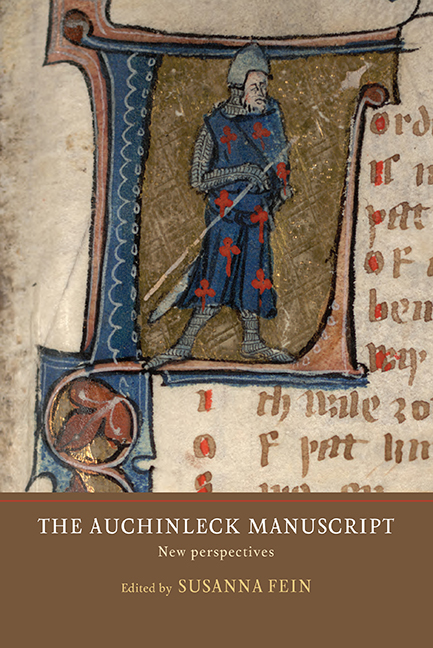Book contents
- Frontmatter
- Contents
- List of Illustrations
- List of Contributors
- Acknowledgements
- Abbreviations
- Note on the Presentation of Auchinleck Texts
- Introduction The Auchinleck Manuscript: New Perspectives
- 1 The Auchinleck Manuscript Forty Years On
- 2 Codicology and Translation in the Early Sections of the Auchinleck Manuscript
- 3 The Auchinleck Adam and Eve: An Exemplary Family Story
- 4 A Failure to Communicate: Multilingualism in the Prologue to Of Arthour and of Merlin
- 5 Scribe 3’s Literary Project: Pedagogies of Reading in Auchinleck’s Booklet 3
- 6 Absent Presence: Auchinleck and Kyng Alisaunder
- 7 Sir Tristrem, a Few Fragments, and the Northern Identity of the Auchinleck Manuscript
- 8 The Invention of King Richard
- 9 Auchinleck and Chaucer
- 10 Endings in the Auchinleck Manuscript
- 11 Paraphs, Piecework, and Presentation: The Production Methods of Auchinleck Revisited
- 12 Scribal Corrections in the Auchinleck Manuscript
- 13 Auchinleck ‘Scribe 6’ and Some Corollary Issues
- Bibliography
- Index of Manuscripts Cited
- General Index
- Manuscript Culture in the British Isles
10 - Endings in the Auchinleck Manuscript
Published online by Cambridge University Press: 21 May 2021
- Frontmatter
- Contents
- List of Illustrations
- List of Contributors
- Acknowledgements
- Abbreviations
- Note on the Presentation of Auchinleck Texts
- Introduction The Auchinleck Manuscript: New Perspectives
- 1 The Auchinleck Manuscript Forty Years On
- 2 Codicology and Translation in the Early Sections of the Auchinleck Manuscript
- 3 The Auchinleck Adam and Eve: An Exemplary Family Story
- 4 A Failure to Communicate: Multilingualism in the Prologue to Of Arthour and of Merlin
- 5 Scribe 3’s Literary Project: Pedagogies of Reading in Auchinleck’s Booklet 3
- 6 Absent Presence: Auchinleck and Kyng Alisaunder
- 7 Sir Tristrem, a Few Fragments, and the Northern Identity of the Auchinleck Manuscript
- 8 The Invention of King Richard
- 9 Auchinleck and Chaucer
- 10 Endings in the Auchinleck Manuscript
- 11 Paraphs, Piecework, and Presentation: The Production Methods of Auchinleck Revisited
- 12 Scribal Corrections in the Auchinleck Manuscript
- 13 Auchinleck ‘Scribe 6’ and Some Corollary Issues
- Bibliography
- Index of Manuscripts Cited
- General Index
- Manuscript Culture in the British Isles
Summary
WHEN one consults either the digital or the print facsimile of the Auchinleck manuscript (Edinburgh, NLS, MS Advocates 19. 2. 1), one of the codicological notes encountered most frequently is ‘Ends imperfect’. This statement is true, first, of the whole manuscript. The last item in the codex as it exists today, The Simonie, itself ends imperfect, and, as David Burnley and Alison Wiggins note, ‘has the original item number lx (60)’, a designation which indicates further ‘imperfection’ in the completeness of the reading experience one can have with the manuscript today. Since only forty-three manuscript items survive, the numbering here indicates that at least seventeen items have been lost and we cannot know, because The Simonie ends imperfect, whether more items originally followed that poem and have also been lost. While the manuscript itself ‘ends imperfect’, so do a number of its extant texts. Burnley and Wiggins note that ‘Frequently, the first leaf of a new text (where the miniature was positioned) has been cut out or, in some cases, just the miniature itself has been excised, … resulting in a series of lacunae throughout the manuscript’. The excision of one text's beginning often means the loss of the previous text's ending, as happens, for example, with Seynt Katerine. This saint's life immediately precedes St Patrick's Purgatory, and that text's imperfect beginning is attributed by I. C. Cunningham to ‘a desire for the miniature’ and the excision of a folio containing it which would also have contained the terminal lines of Seynt Katerine. In other places, entire gatherings that would have included a text's ending have been lost, as is the case for King Richard. For twenty-five items, however, we do have what one might call ‘perfect’ endings, namely original terminations preserved in the manuscript as it exists today.
- Type
- Chapter
- Information
- The Auchinleck Manuscript: New Perspectives , pp. 156 - 175Publisher: Boydell & BrewerPrint publication year: 2016

